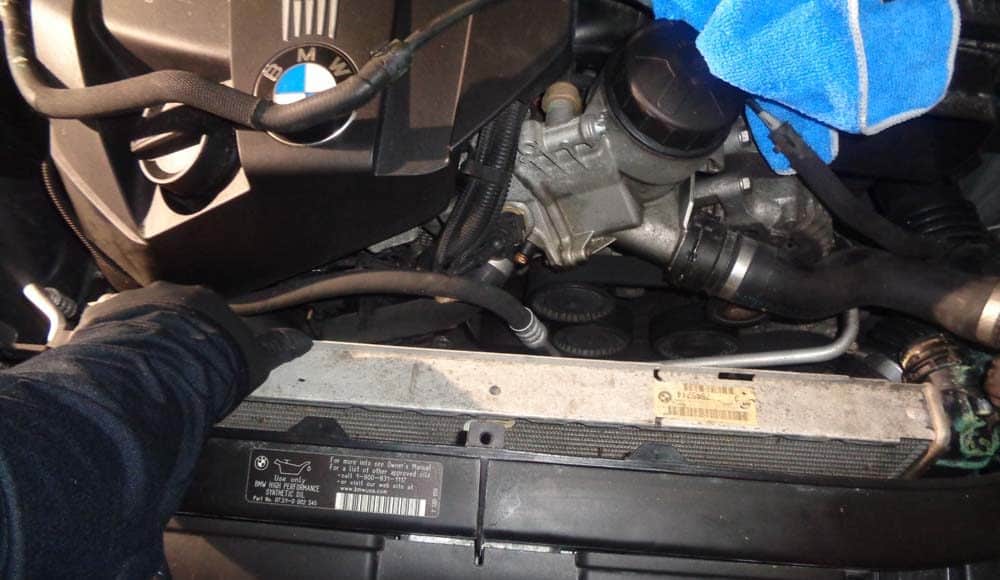Affiliate link disclosure – The BMW Repair Guide uses affiliate links in their site. For more information on affiliate links, please click here.
Repair Summary
The following article gives detailed instructions on replacing the radiator in a BMW E9x 3 series vehicle. Even though we have used a 2011 BMW 335i to perform this installation, this article can be applied to any E9x 3 series vehicle produced from 2007-2013 with minor modifications.
See all vehicles this article applies to
E90 3 Series M3
E90 3 Series 318d
E90 3 Series 335i
E90 3 Series 335xi
E90 3 Series 335d
E90 3 Series 330xd
E90 3 Series 330xi
E90 3 Series 330i
E90 3 Series 330d
E90 3 Series 328xi
E90 3 Series 328i
E90 3 Series 325xi
E90 3 Series 325i
E90 3 Series 323i
E90 3 Series 325d
E90 3 Series 320i
E90 3 Series 320si
E90 3 Series 320d
E90 3 Series 318i
E90 3 Series 316i
E90N 3 Series M3 CRT
E90N 3 Series 318i
E90N 3 Series M3
E90N 3 Series 335xi
E90N 3 Series 335i
E90N 3 Series 335d
E90N 3 Series 330xd
E90N 3 Series 330xi
E90N 3 Series 330i
E90N 3 Series 328xi
E90N 3 Series 330d
E90N 3 Series 328i
E90N 3 Series 325d
E90N 3 Series 325i
E90N 3 Series 325xi
E90N 3 Series 323i
E90N 3 Series 320xd
E90N 3 Series 320i
E90N 3 Series 320d ed
E90N 3 Series 320d
E90N 3 Series 318d
E90N 3 Series 316i
E90N 3 Series 316d
A BMW E90 radiator replacement is a common repair for these aging fifth generation 3 series cars.
While recently driving our BMW Repair Guide 2011 335i, we noticed the engine coolant "low level" light kept popping up on the instrument cluster. Further investigation found fluid seeping out of the left portion of the radiator where the upper coolant hose attaches. The wear and tear of only eight years of driving had caused a hairline fracture in the radiator. This has become a very familiar story among owners of older high mileage E90 3 series cars.
It's hard to believe, but the fifth generation of the BMW 3 series cars are starting to age. Many of the BMW E90 vehicles on the road are over 10 years old. Age, heat, and pressure take their toll on plastic radiator parts...especially around the areas that have hose connections. Hairline fractures can form spewing coolant into the engine compartment. Eventually, the radiator can fail, causing engine overheating and possible catastrophic damage.
The good news is a BMW E90 radiator replacement sounds more complicated than it really is. In fact, it's a fairly easy repair for the home mechanic and can be completed in a couple of hours. In the following steps we use a turbocharged 335i as our repair car...but this article can be used to replace the radiator on any E90 3 series vehicle produced from 2007-2013 with minor modifications.
Please look at part short descriptions for your vehicle's correct fitment. Radiator part numbers can vary for different E9x models.



View the detailed parts diagram for this repair.
Includes detailed part diagrams, part numbers and links to purchase all of the required components needed to complete this repair.

Before starting this repair, you must have the following required parts.
All E9x 328i models with N51 engine and manual transmission
This is the same factory radiator that would be installed at the BMW dealership.
All E9x 328i models with N51 engine and automatic transmission
This is the same factory radiator that would be installed at the BMW dealership.
All E9x 325i,328i and 330i with N52 engine and automatic transmission
Keep your engine properly cooled with this genuine radiator replacement.
All E9x 325i,328i and 330i with N52 engine and manual transmission
Keep your engine properly cooled with this genuine radiator replacement.
All E9x 335i models with N54/55 engine and manual transmission
Keep your engine properly cooled with this genuine radiator replacement.
All E9x 335i models with N54/55 engine and automatic/dual clutch transmission
Keep your cooling system functioning properly with a new radiator.
All BMW E9x 335i
This is the same factory part that would be installed at the BMW dealership.
BMW E9x 325i, 328i, and 330i with manual transmission
This is the same factory part that would be installed at the BMW dealership.
BMW E9x 325i,328i, and 330i with automatic transmission
This is the same factory part that would be installed at the BMW dealership.
Fits all BMW vehicles
This is the same Genuine BMW coolant you would buy from the dealership.
Section 1 - Preparing for the BMW E90 Radiator Removal
- You will need to jack and support your vehicle since you will need to get under the front of the vehicle to drain the radiator. Please click here to learn how to properly jack and support your vehicle for this repair.
- Remove the electric engine cooling fan. For instructions on how to do this, please read our article BMW E90 Cooling Fan Replacement – 2007-2013 3 Series.
- Remove the coolant reservoir cap. The cap must be removed for the BMW E90 radiator to drain properly.
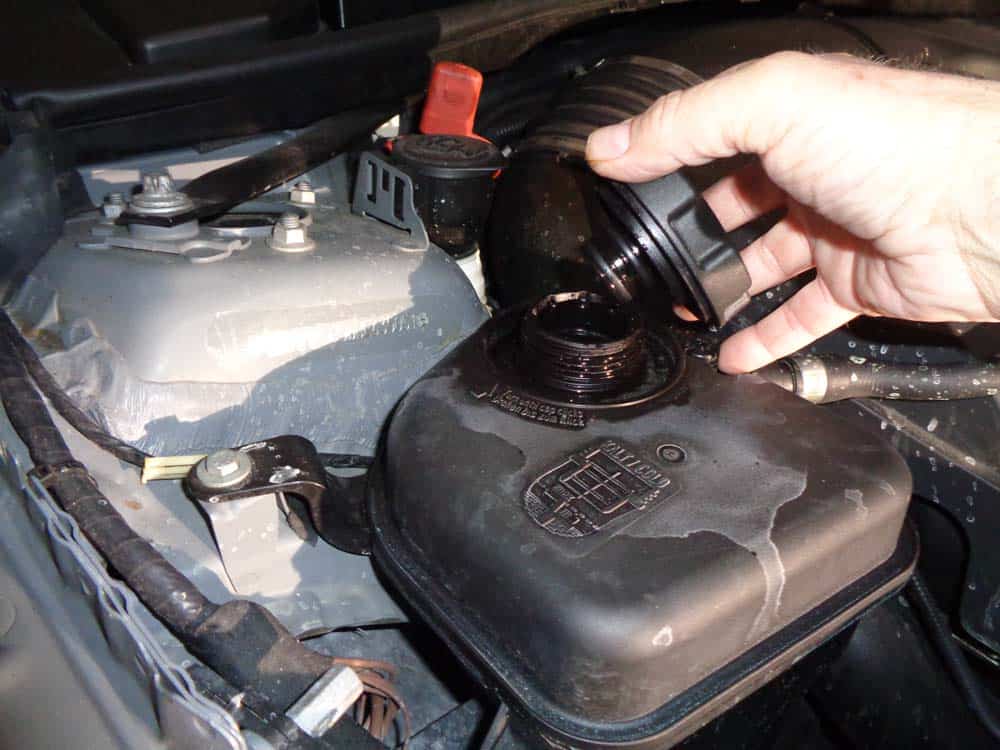
- Remove protective plastic belly pan (skid plate) from the underside of your vehicle. It is held in place with 8mm screws.
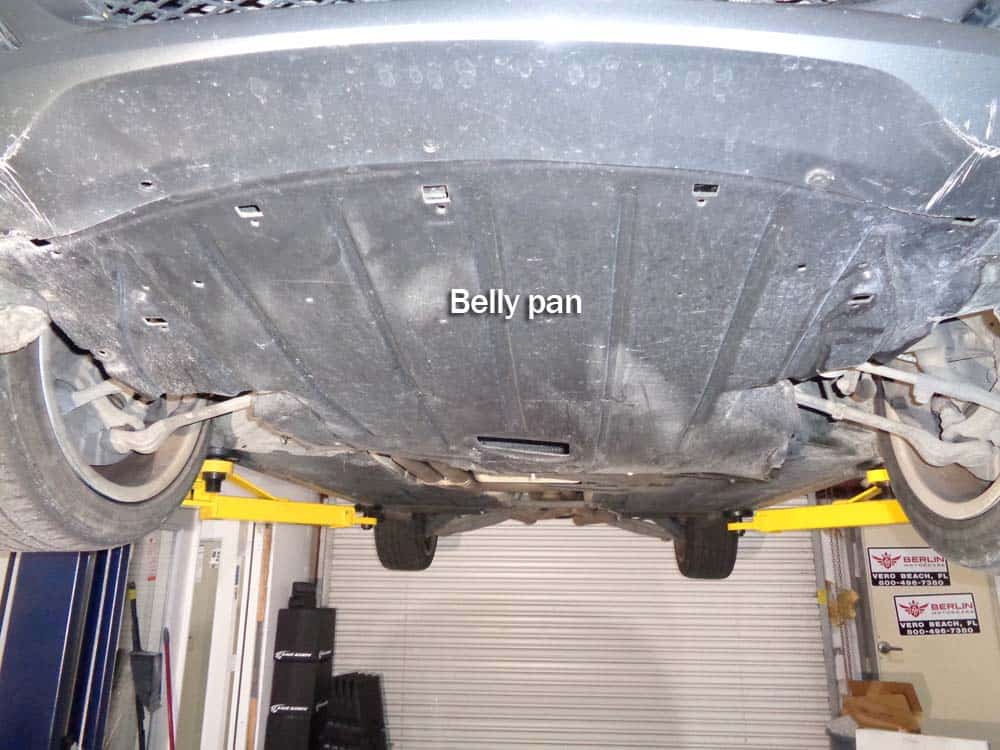
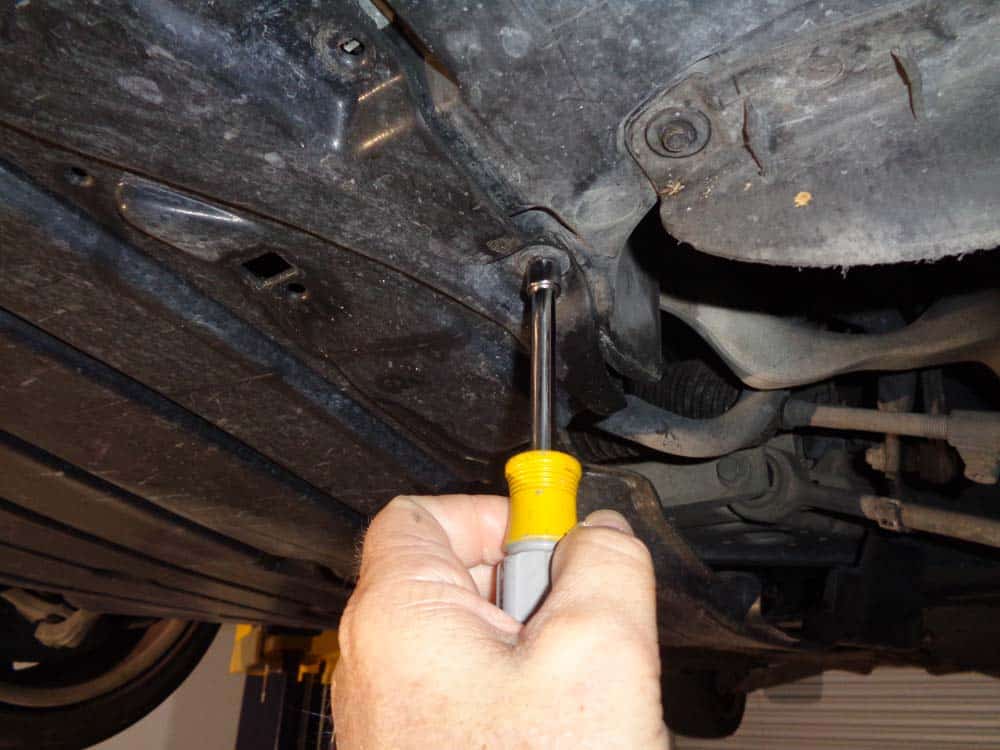
- BMW 335i (turbo-charged) models (all other models proceed to step 8) - Unfasten the two clips holding the plastic protective shield to the bottom of the intercooler. They simply lift up and turn to release.
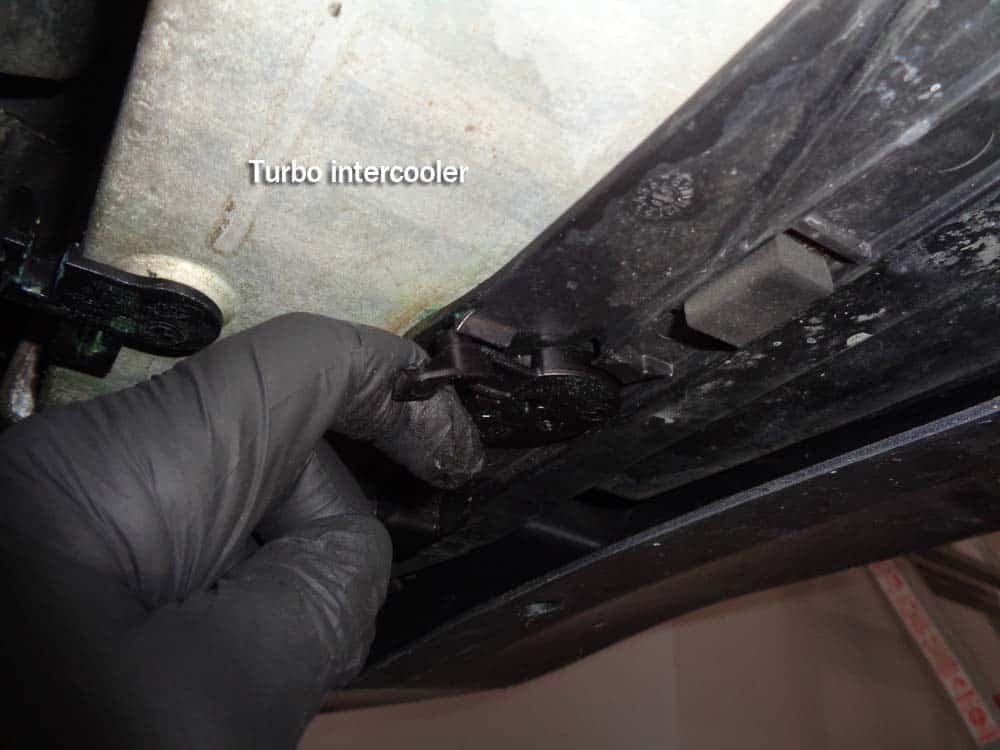
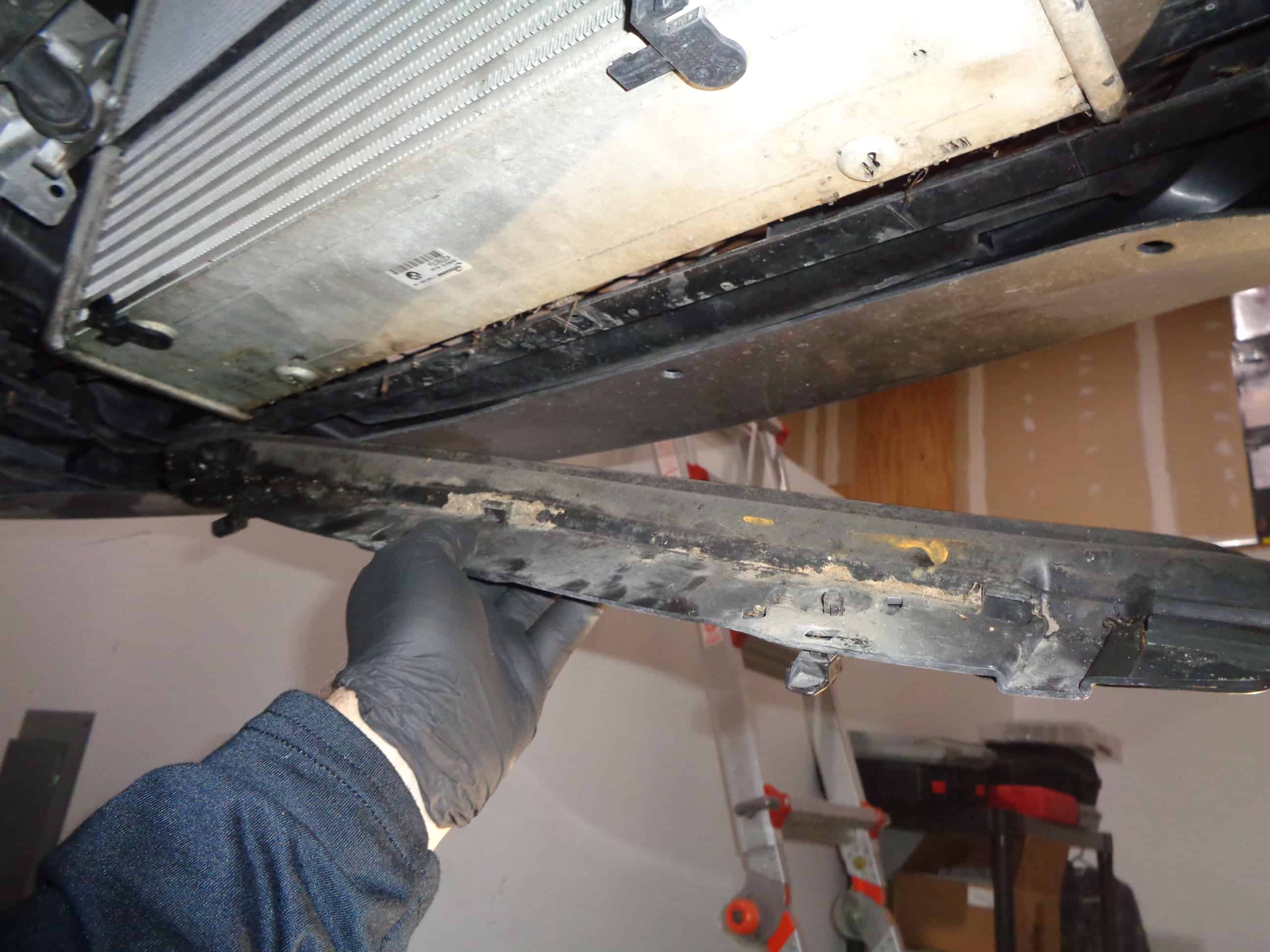
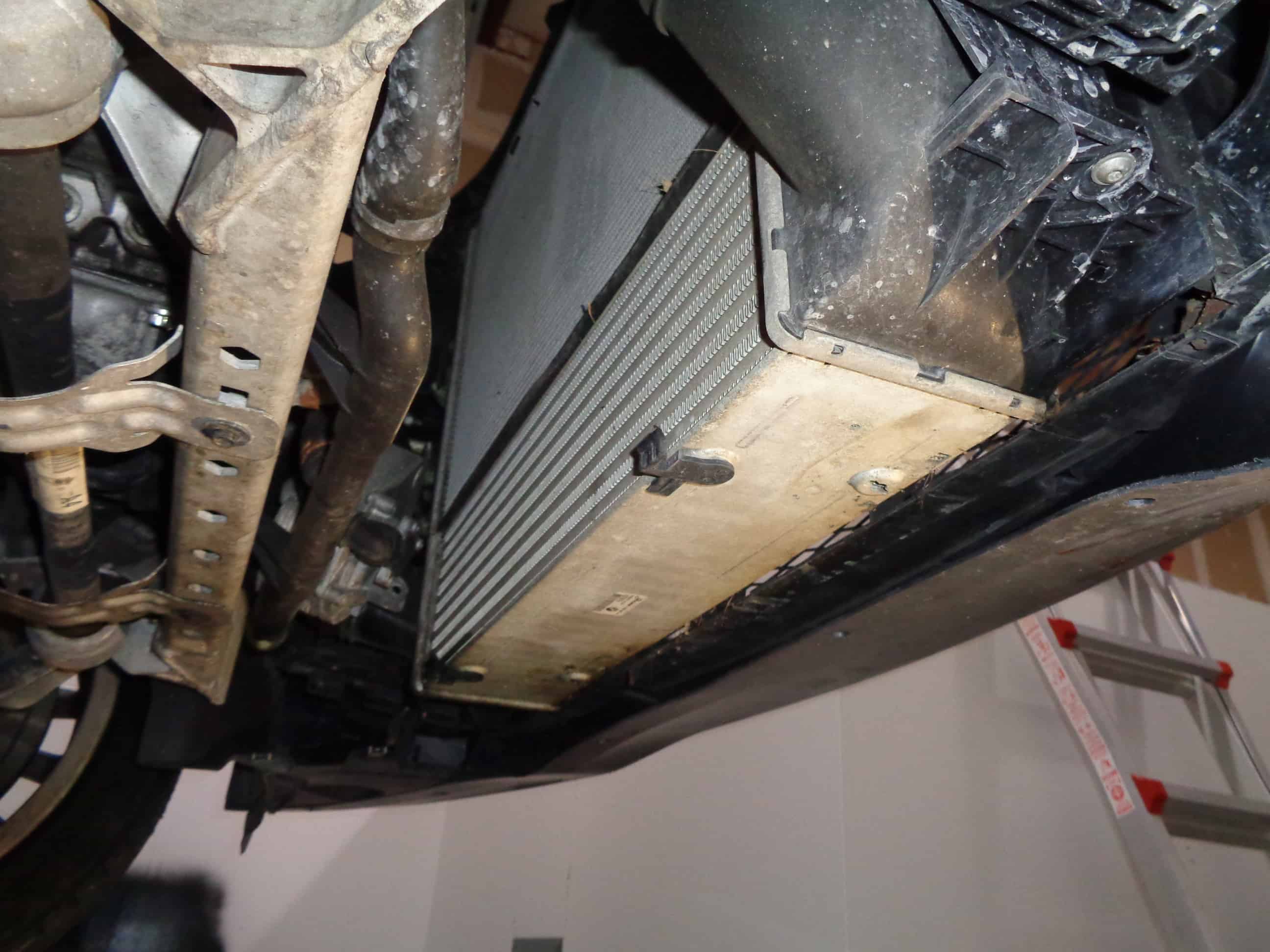
- BMW 335i (turbo charged) models continued - Using a flat blade screwdriver, release the retaining clips on the two intercooler hoses.
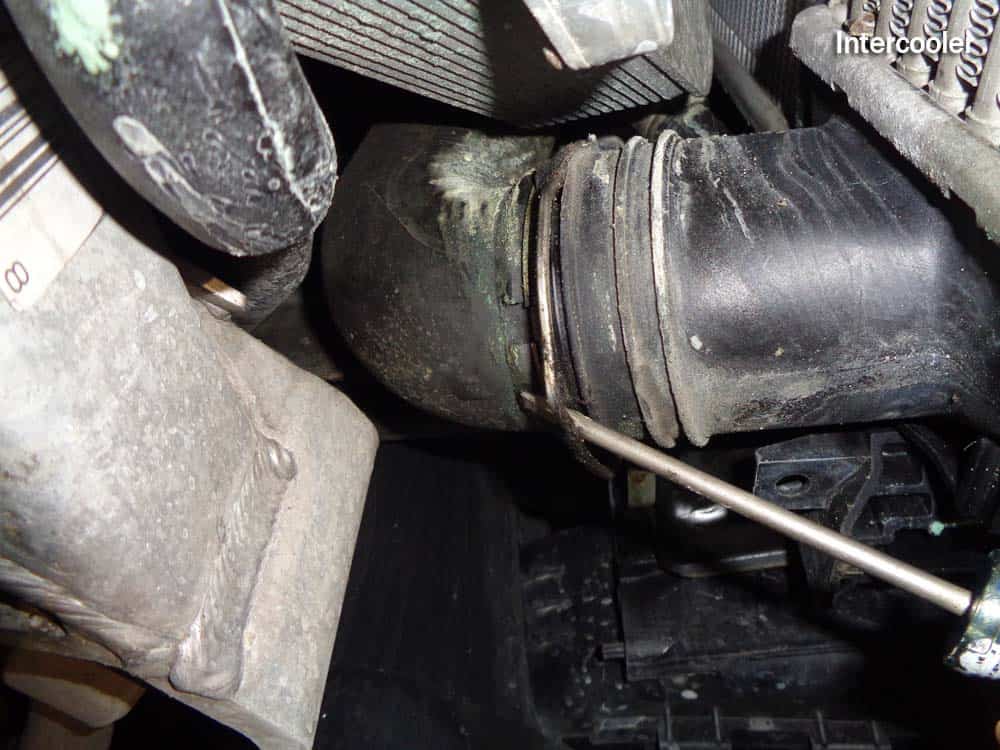
- BMW 335i (turbo charged) models continued - Remove the two T25 torx screws anchoring the intercooler to the vehicle. Grasp the intercooler and carefully remove from vehicle.
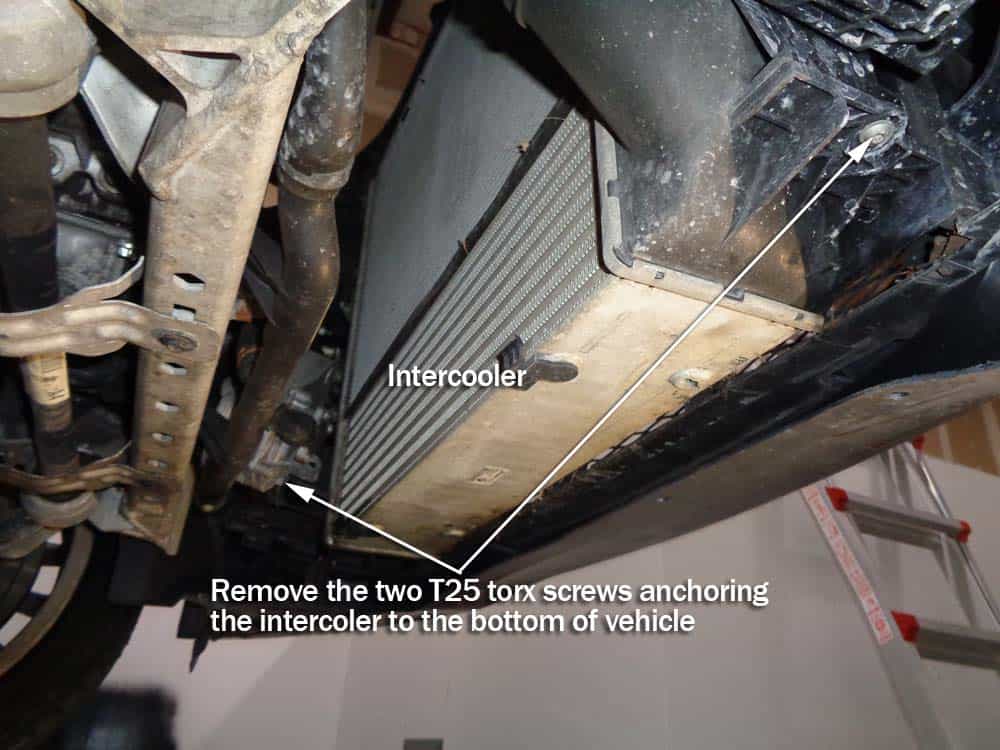
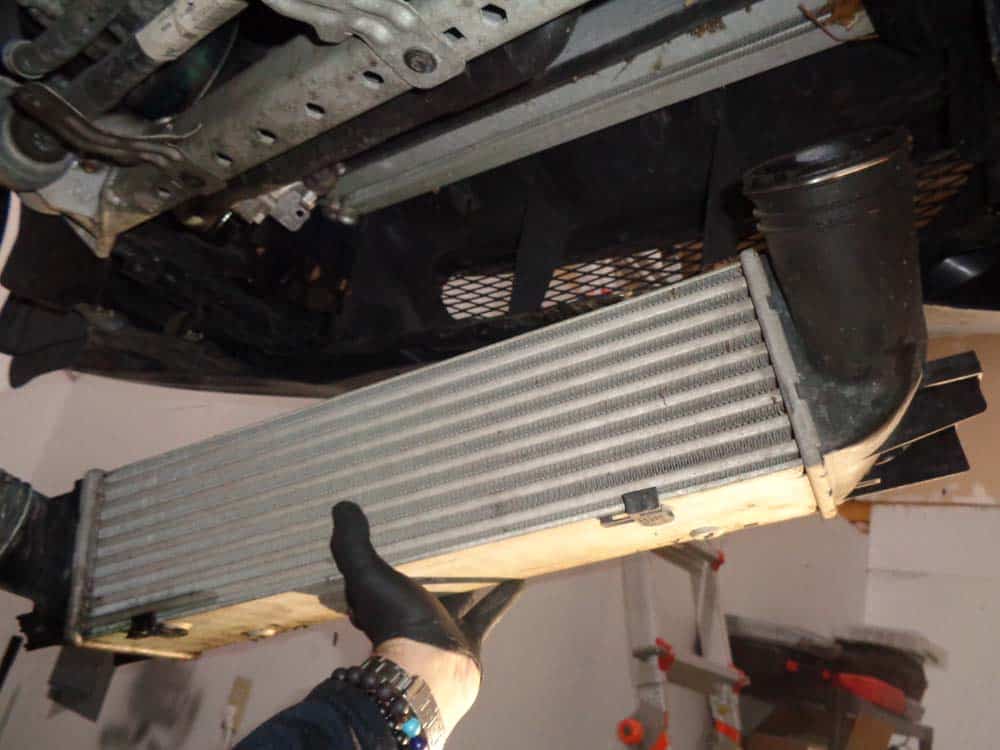
- Using a large flat blade screwdriver, unscrew and remove the radiator drain plug. Have a 5 gallon drain pan ready to catch the fluid. Let the radiator completely drain.
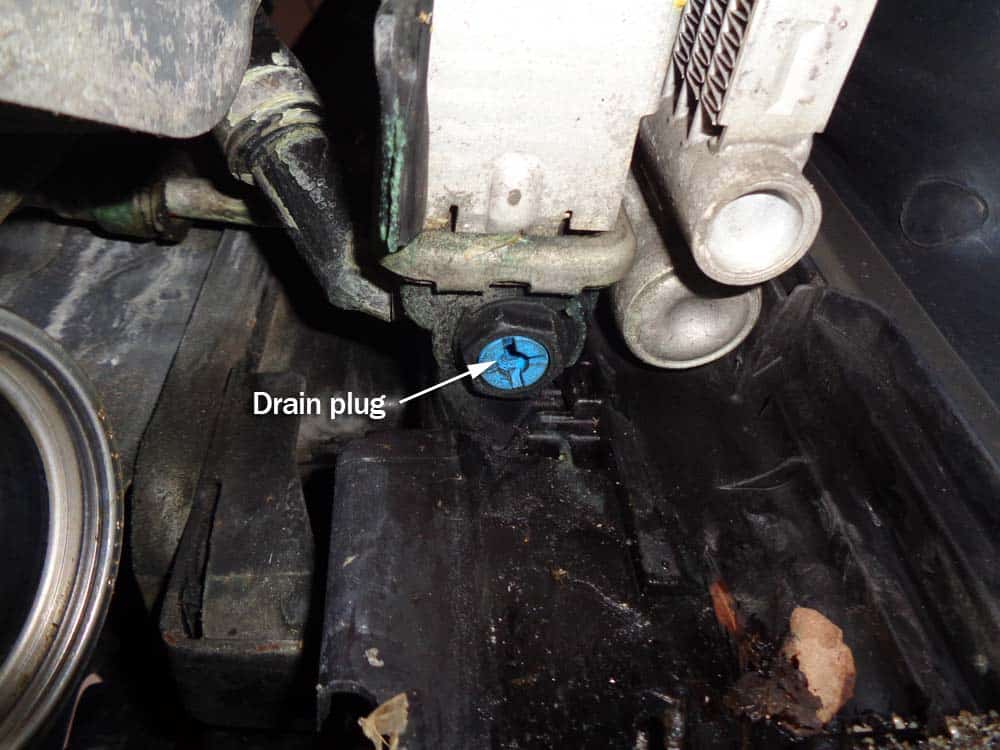
- After the BMW E90 radiator has drained, move back to engine compartment and remove the upper radiator hose by releasing its retaining clips and pulling loose from the oil filter housing and the upper radiator. Be VERY CAREFUL not to break the plastic fitting that connects the fluid reservoir overflow tube to the upper radiator hose. Gently push the hose back towards the firewall so is out of the way of the radiator (we tucked ours behind the oil filter housing with a towel - see image below).
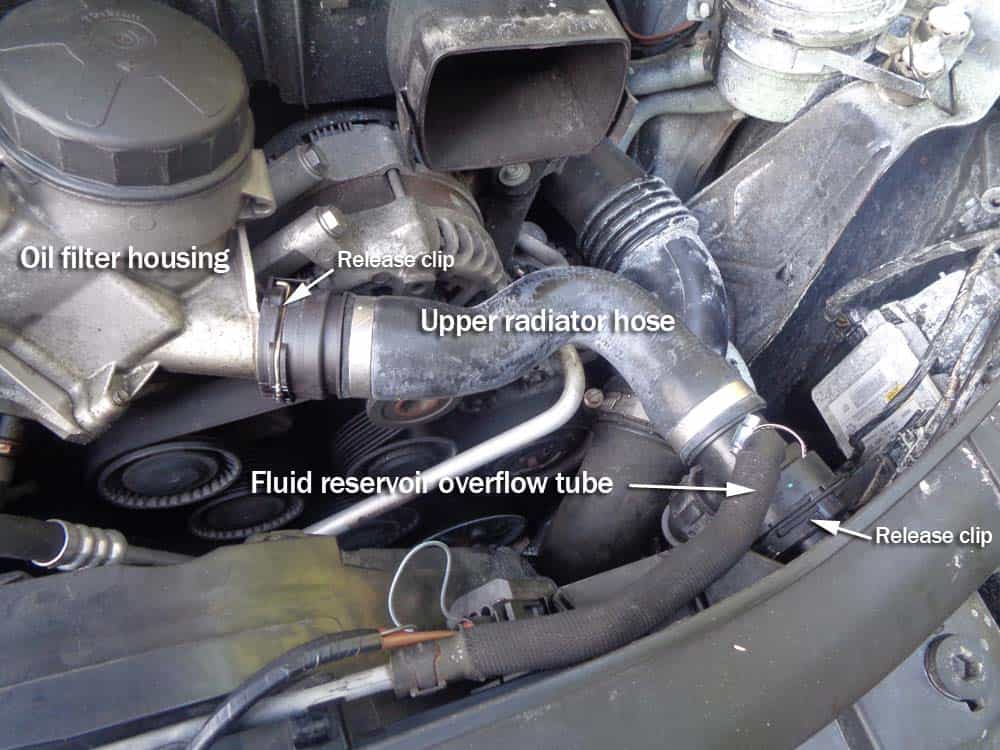
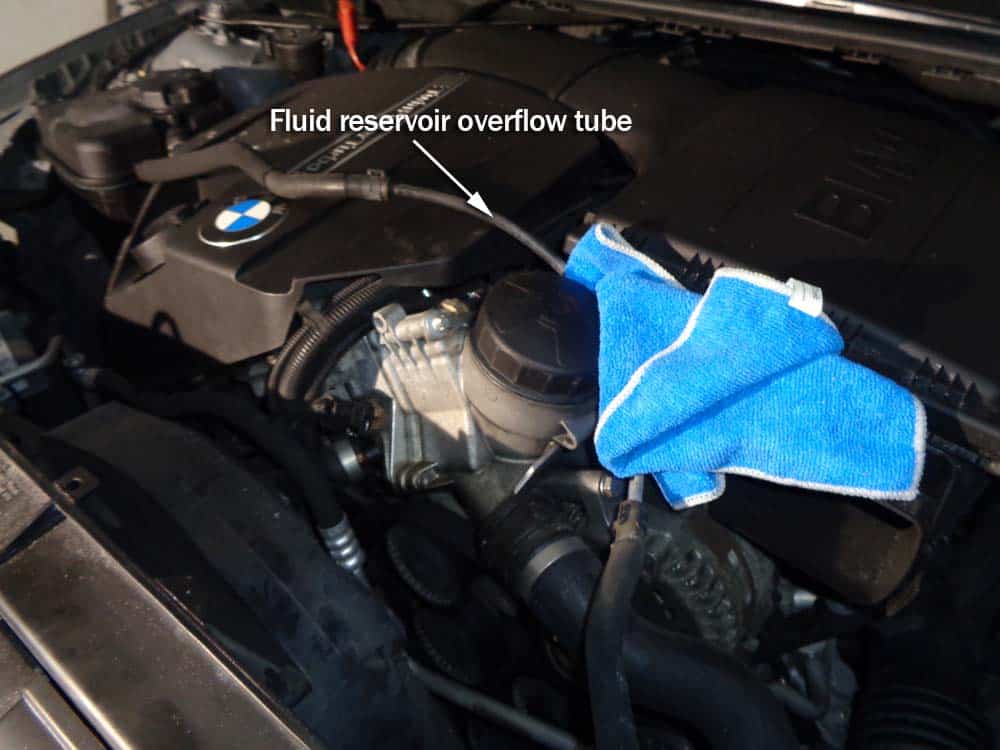
- Working on the right side of the radiator, release the retaining clips on the two lower radiator hoses and gently pry off of radiator. You may have to get back under car to reach one of the clips.
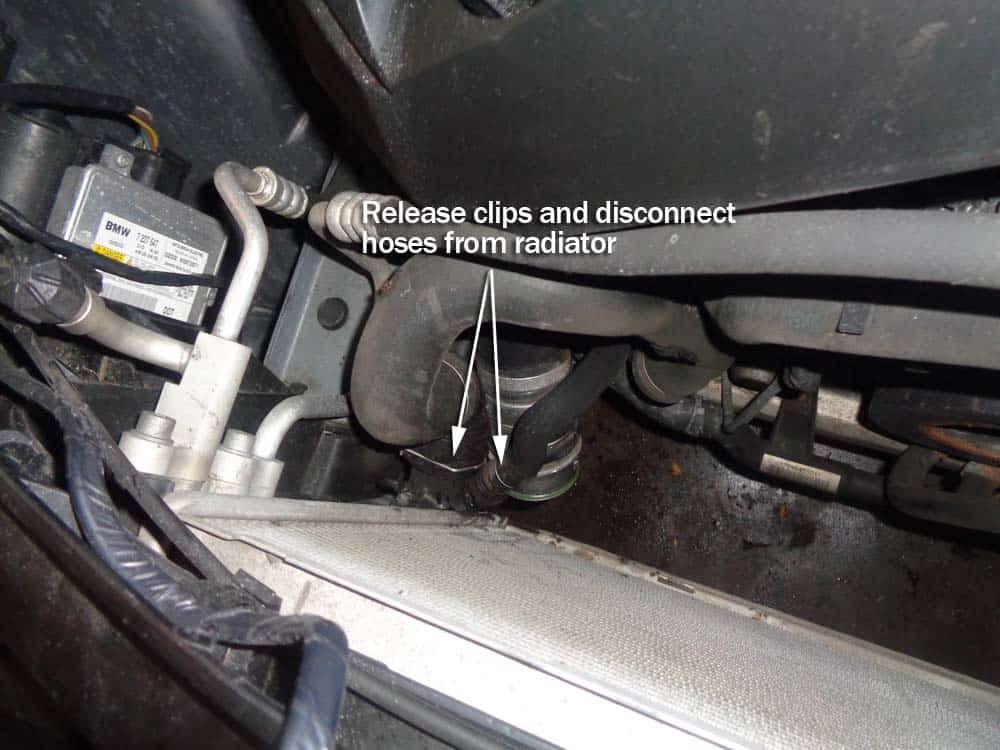
- Working on the left side of the radiator, remove the oil cooler hose that is attached to the bottom of the radiator. The oil cooler hose is anchored to the radiator with a plastic mount that is secured with a T25 torx screw.
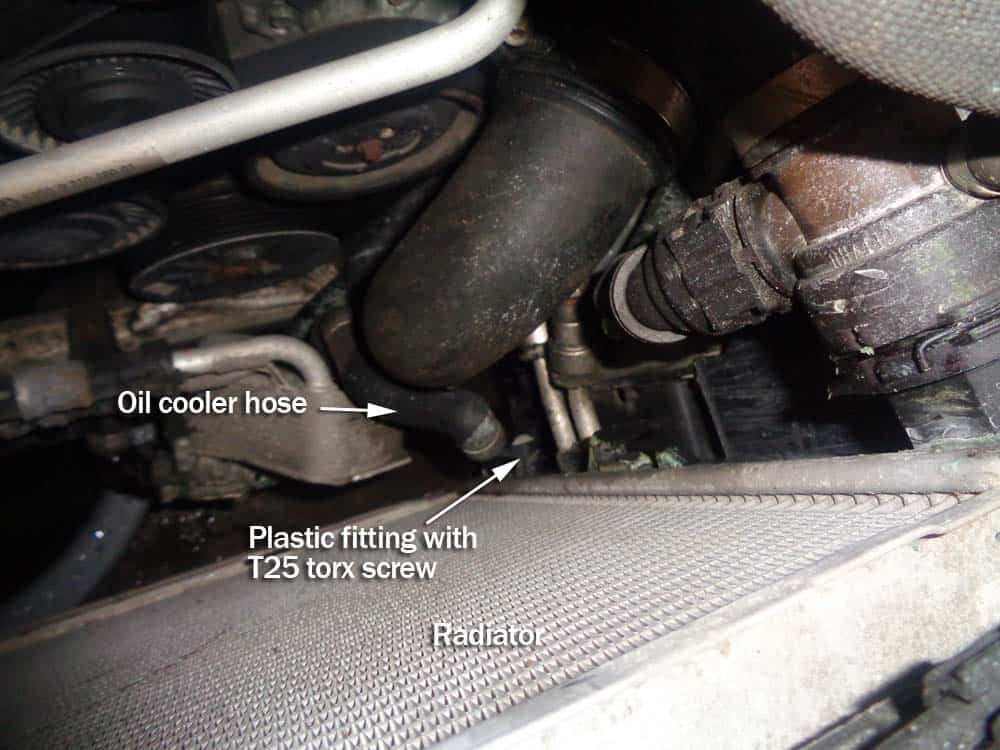
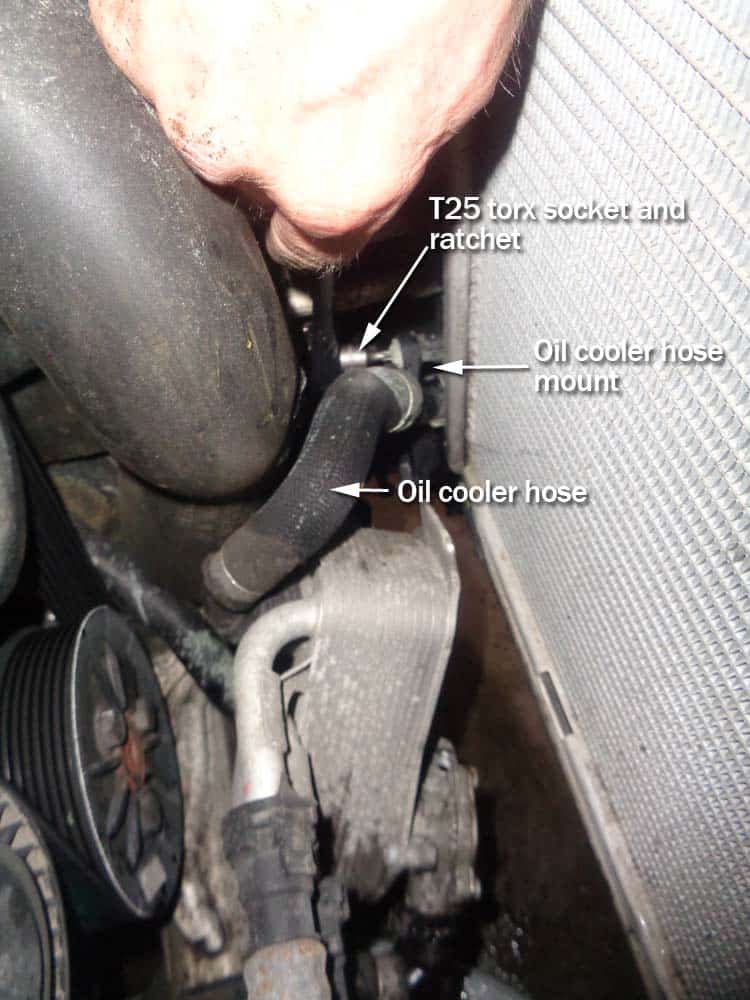
- Remove the two T25 torx screws anchoring the top of the radiator to the frame of the vehicle.
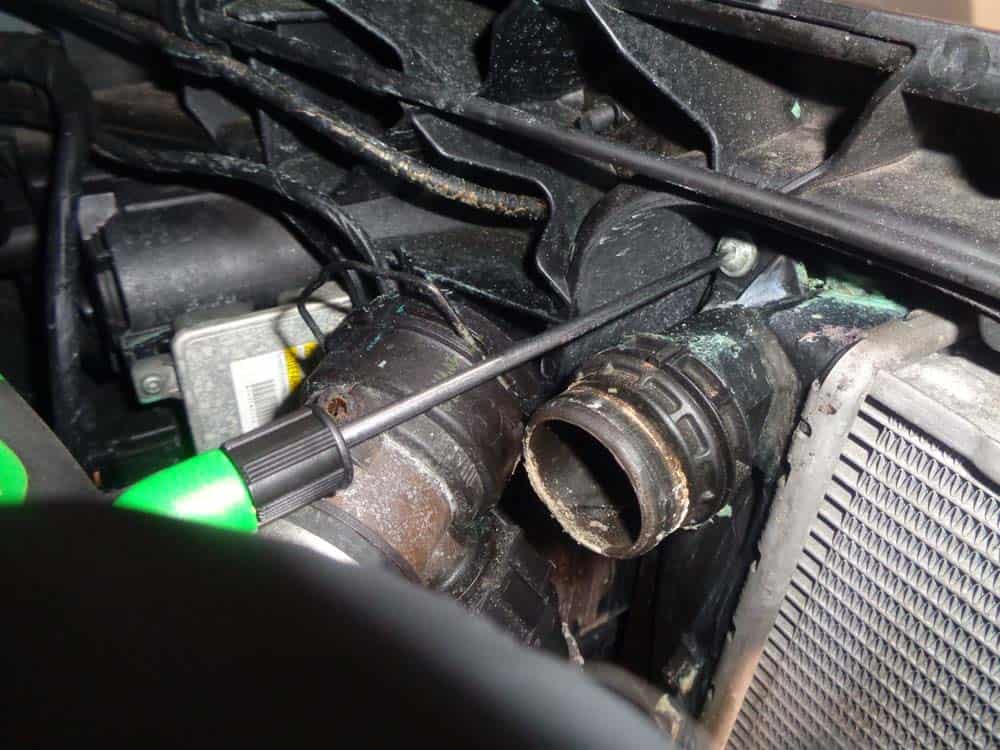
- Grasp top of radiator with two hands and remove from vehicle. Work slowly so you don't snag any pipes or electrical connections. It usually helps to slightly tilt radiator towards rear of car when removing.
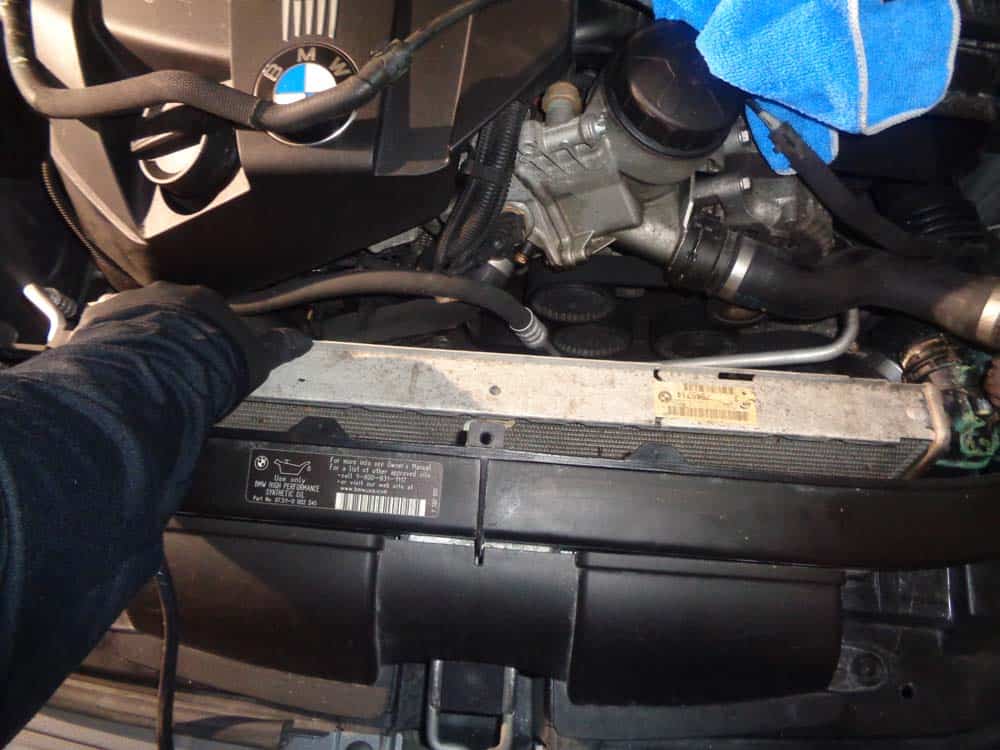
Section 2 - Preparing the New BMW E90 Radiator for Installation
The new BMW E90 radiator will need to be prepped prior to installation, since they are usually shipped without the drain plug assembly or the two plastic hose mounts installed.- Unpack the new drain plug assembly that is included with your radiator. If you did not get a new drain plug assembly then you will need to purchase one before proceeding (see our parts section above). Never reuse your old drain plug...they can fail causing your engine to overheat.
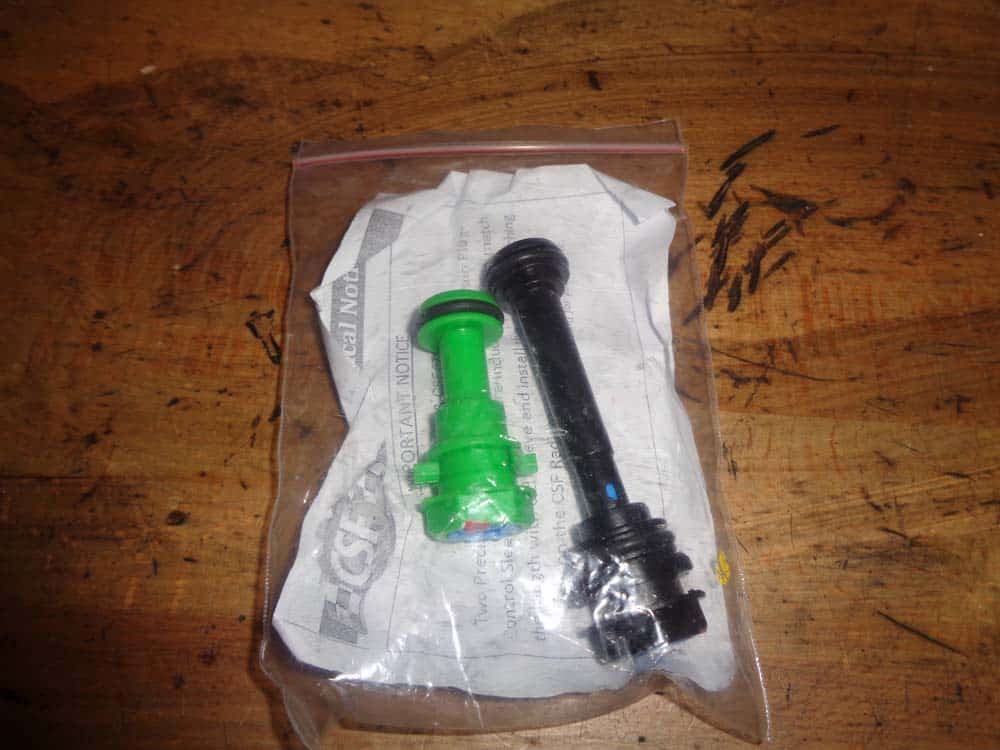
- Install the drain plug sleeve into the new radiator. Push firmly to make sure all of the o-rings are seated properly, then turn it to lock it into position. ***It is very important that you pull on the sleeve to verify it has locked into the radiator. Only proceed to the next step once you are sure the sleeve has been installed correctly and wont slip out.
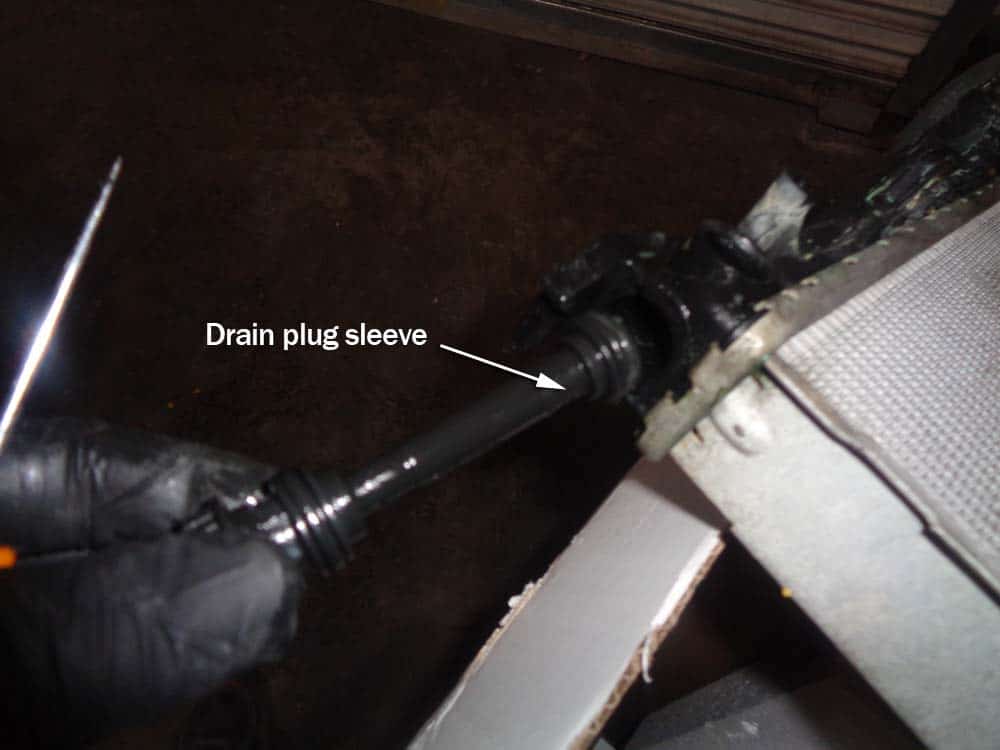
- Install drain plug and tighten (do not over-tighten).
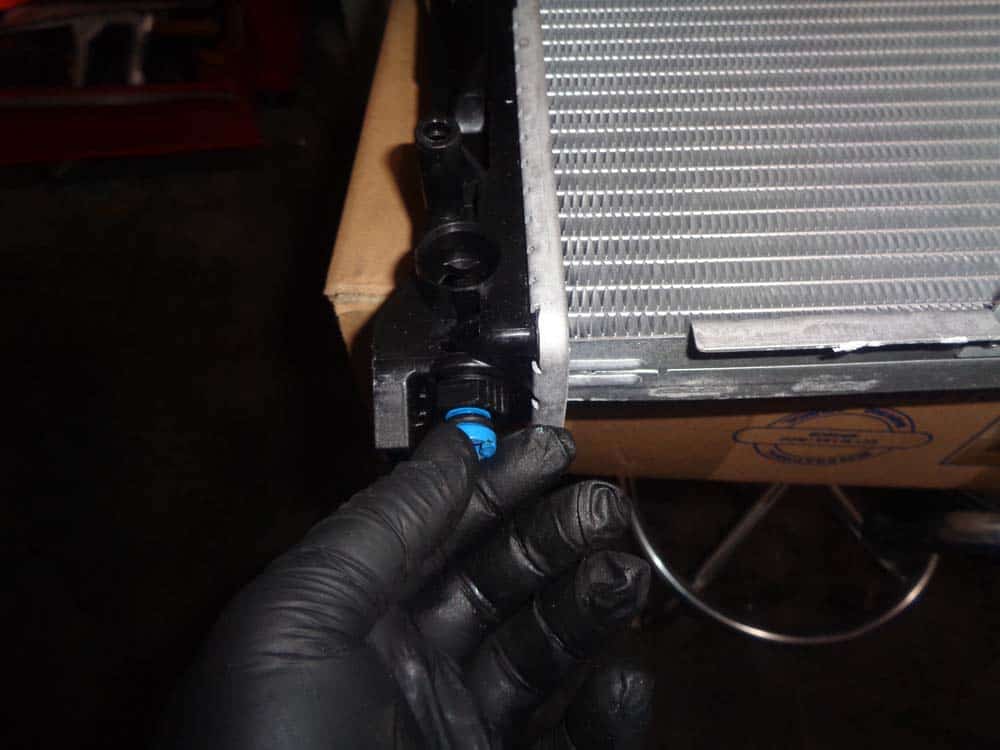
- Remove the right side plastic hose mount (connector) from the old radiator by removing the T25 torx screw and GENTLY prying it out with a flat blade screwdriver. Reinstall in new radiator.
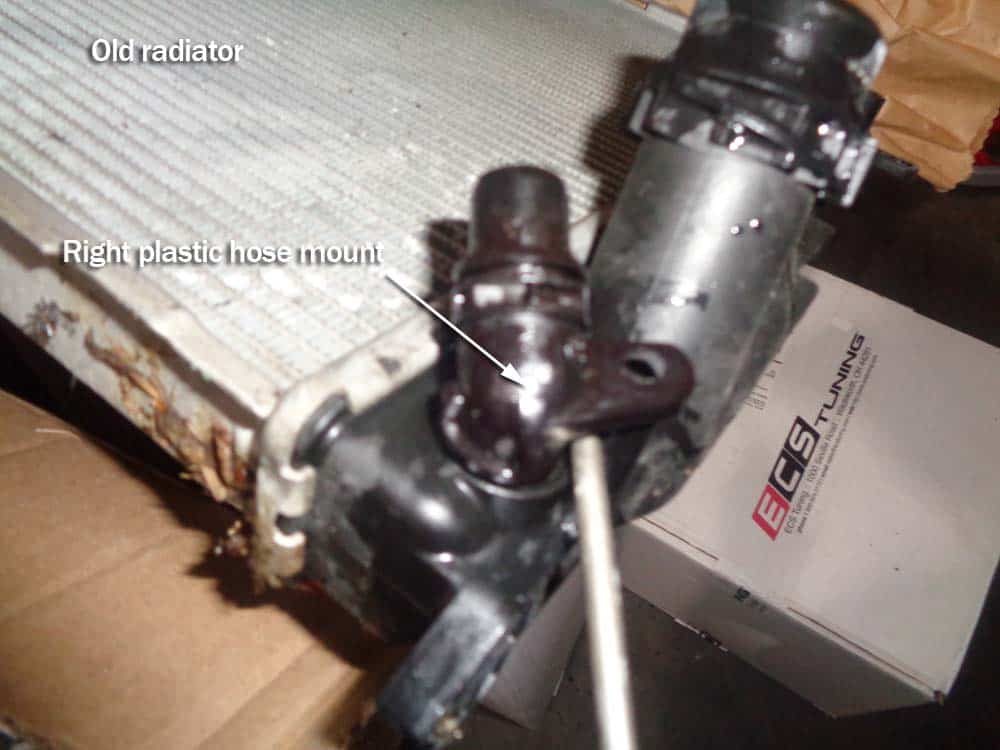
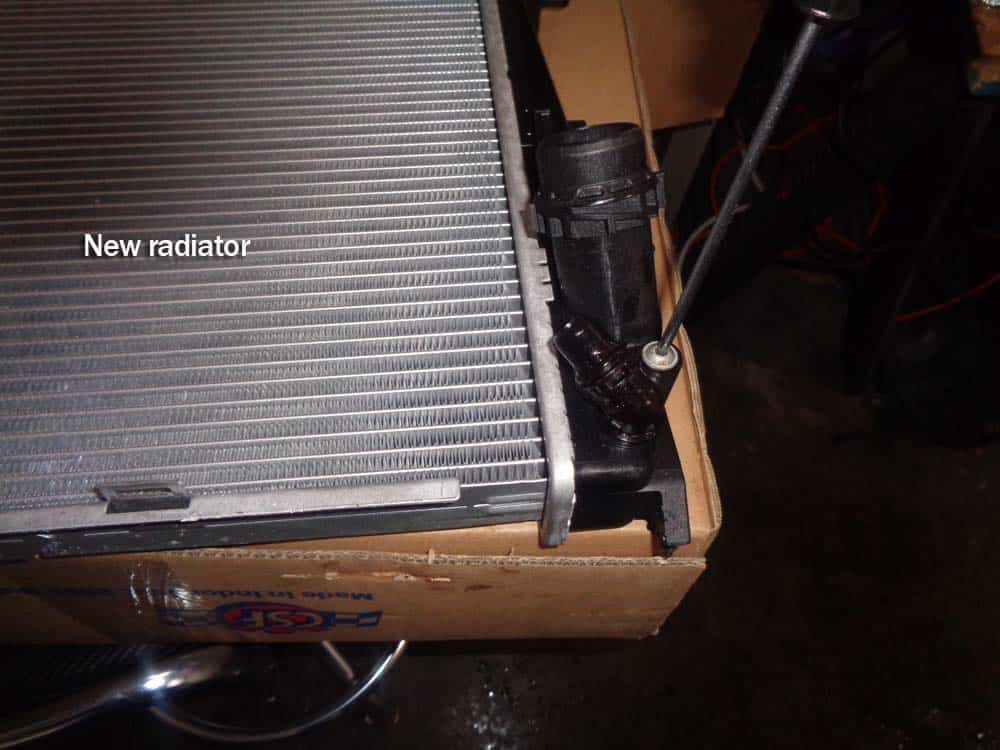
Section 3 - Installing the New BMW E90 Radiator
Installing the new radiator is very straightforward...just follow the steps in Section 1 in reverse. Remember that when reinstalling the coolant hoses you want to close the release clip before sliding them onto the connection. Make sure to hear them "snap" into place. [content_block slug=content-block-article-block-4]Section 4 - Refilling and bleeding the system
Only refill your BMW E90 radiator with Genuine BMW Antifreeze/Coolant mixed 50/50 with distilled water. We do not recommend using any other brand.- The BMW E90 3 series uses an electric water pump which requires a special procedure for bleeding. You will need to hook up a battery charger to the vehicle during the bleeding process to avoid draining the battery. Always connect the battery charger to the positive terminal and ground in the engine compartment...never connect it directly to the battery. Connecting a battery charger directly to the battery may cause damage to sensitive control modules.
- Slowly fill the expansion tank with coolant until it reaches its maximum level.
- If your car has a bleed screw on the upper radiator hose, open it with a flat blade screwdriver (if not proceed to step 4). If coolant does not emerge from the bleed screw, continue to fill the expansion tank until it starts to trickle out. Tighten the bleed screw.
- Next, loosen the bleed screw on the expansion tank. If coolant does not stream out, fill the expansion tank until it does. Tighten the bleed screw.
- Put the cap back on the expansion tank.
- Connect the battery charger to the positive terminal and ground bolt in the engine compartment and start charging the battery.
- Switch on the ignition (do not start the vehicle).
- Set the heater to its maximum temperature and set the fan speed to its lowest setting.
- Press and hold the accelerator pedal to the floor for 10 seconds.
- The coolant system bleeding procedure begins when the accelerator pedal is released and lasts for about 12 minutes. You will hear the electric coolant pump cycling on and off during this time.
- When the bleeding procedure is finished, disconnect the battery charger and add coolant to the expansion tank if necessary.
BMW E90 Radiator Replacement Finished

